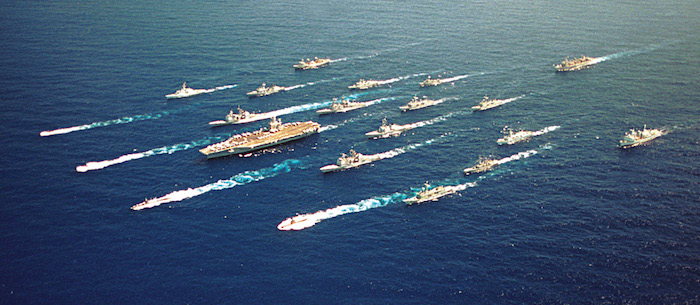



On 1 October 2004, carrier groups and cruiser-destroyer groups were redesignated carrier strike groups. Each of the Navy's 12 existing carrier battle groups consisted of an aircraft carrier an embarked carrier air wing cruisers, destroyer, and frigate units and two nuclear-powered attack submarines. Navy instituted a concept that mandated greater task group integration of naval air and surface warfare assets into a more permanent carrier battle group structure. Navy's aircraft carrier groups were officially referred to as Carrier Battle Groups (CVBGs), and were commanded by either flag officers called Cruiser-Destroyer Group (CRUDESGRU) or Carrier Group (CARGRU) commanders. Carrier Division 1 was redesignated Carrier Group 1 on 30 June 1973, and seemingly all Carrier Divisions were redesignated Carrier Groups on that date. The single-carrier battle group was born with the military drawdown that followed World War II. Operationally they were assigned to Task Forces, of which Task Force 11, Task Force 16 and Task Force 17 perhaps gained the most fame for their roles in the Battle of the Coral Sea and the Battle of Midway. In World War II, administratively, aircraft carriers were assigned to carrier divisions (CARDIVs). Navy carrier battle group can be traced to the 1920s and was initially based on previous experience grouping battleships and other major surface combatants. Thus, from a command and control perspective, carrier strike groups are combat organized by mission rather than by platform. Other ships in the strike group sometimes undertake offensive operations (launching cruise missiles, for instance) and the carrier's air wing contributes to the strike group's defense (through combat air patrols and airborne anti-submarine efforts). The principal role of the carrier and its air wing within the carrier strike group is to provide the primary offensive firepower, while the other ships provide defense and support. The carrier strike group is a flexible naval force that can operate in confined waters or in the open ocean, during day and night, in all weather conditions. As of March 2016 there are 10 carrier strike groups in the U.S. Previously referred to as carrier battle groups (a term still used by other nations), they are often referred to by the carrier they are associated with (e.g., Enterprise Strike Group). power projection capability a single supercarrier holds enough firepower to rival the air forces of entire nations. Strike groups comprise a principal element of U.S. The carrier strike group commander operationally reports to the commander of the numbered fleet, who is operationally responsible for the area of waters in which the carrier strike group is operating. A carrier strike group also, on occasion, includes submarines, attached logistics ships and a supply ship. It is an operational formation composed of roughly 7,500 personnel, usually an aircraft carrier, at least one cruiser, a destroyer squadron of at least two destroyers or frigates, and a carrier air wing of 65 to 70 aircraft. Navy ships assigned to the USS George Washington Carrier Strike Group sail in formation in the Atlantic Ocean in November 2003.Ī carrier strike group ( CSG) is a type of carrier battle group of the United States Navy.


 0 kommentar(er)
0 kommentar(er)
